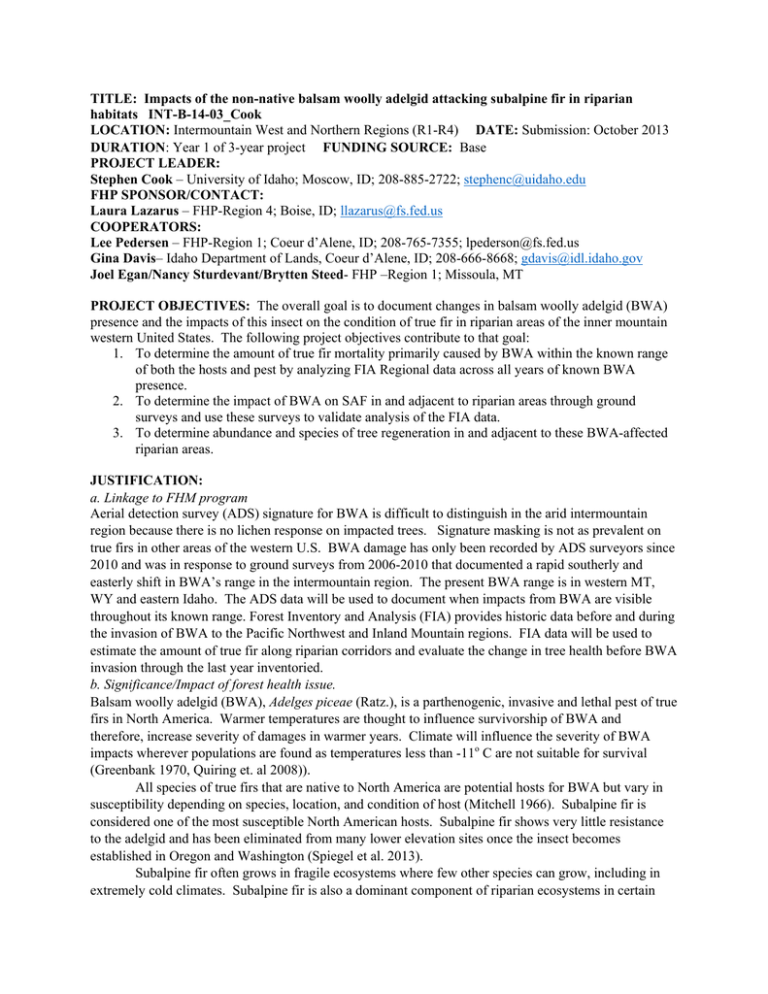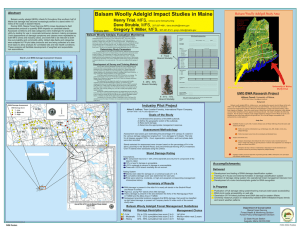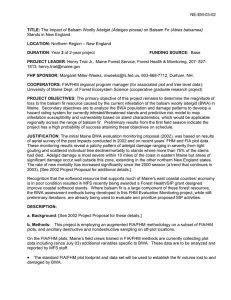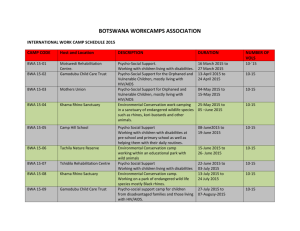TITLE: Impacts of the non-native balsam woolly adelgid attacking... habitats INT-B-14-03_Cook
advertisement

TITLE: Impacts of the non-native balsam woolly adelgid attacking subalpine fir in riparian habitats INT-B-14-03_Cook LOCATION: Intermountain West and Northern Regions (R1-R4) DATE: Submission: October 2013 DURATION: Year 1 of 3-year project FUNDING SOURCE: Base PROJECT LEADER: Stephen Cook – University of Idaho; Moscow, ID; 208-885-2722; stephenc@uidaho.edu FHP SPONSOR/CONTACT: Laura Lazarus – FHP-Region 4; Boise, ID; llazarus@fs.fed.us COOPERATORS: Lee Pedersen – FHP-Region 1; Coeur d’Alene, ID; 208-765-7355; lpederson@fs.fed.us Gina Davis– Idaho Department of Lands, Coeur d’Alene, ID; 208-666-8668; gdavis@idl.idaho.gov Joel Egan/Nancy Sturdevant/Brytten Steed- FHP –Region 1; Missoula, MT PROJECT OBJECTIVES: The overall goal is to document changes in balsam woolly adelgid (BWA) presence and the impacts of this insect on the condition of true fir in riparian areas of the inner mountain western United States. The following project objectives contribute to that goal: 1. To determine the amount of true fir mortality primarily caused by BWA within the known range of both the hosts and pest by analyzing FIA Regional data across all years of known BWA presence. 2. To determine the impact of BWA on SAF in and adjacent to riparian areas through ground surveys and use these surveys to validate analysis of the FIA data. 3. To determine abundance and species of tree regeneration in and adjacent to these BWA-affected riparian areas. JUSTIFICATION: a. Linkage to FHM program Aerial detection survey (ADS) signature for BWA is difficult to distinguish in the arid intermountain region because there is no lichen response on impacted trees. Signature masking is not as prevalent on true firs in other areas of the western U.S. BWA damage has only been recorded by ADS surveyors since 2010 and was in response to ground surveys from 2006-2010 that documented a rapid southerly and easterly shift in BWA’s range in the intermountain region. The present BWA range is in western MT, WY and eastern Idaho. The ADS data will be used to document when impacts from BWA are visible throughout its known range. Forest Inventory and Analysis (FIA) provides historic data before and during the invasion of BWA to the Pacific Northwest and Inland Mountain regions. FIA data will be used to estimate the amount of true fir along riparian corridors and evaluate the change in tree health before BWA invasion through the last year inventoried. b. Significance/Impact of forest health issue. Balsam woolly adelgid (BWA), Adelges piceae (Ratz.), is a parthenogenic, invasive and lethal pest of true firs in North America. Warmer temperatures are thought to influence survivorship of BWA and therefore, increase severity of damages in warmer years. Climate will influence the severity of BWA impacts wherever populations are found as temperatures less than -11o C are not suitable for survival (Greenbank 1970, Quiring et. al 2008)). All species of true firs that are native to North America are potential hosts for BWA but vary in susceptibility depending on species, location, and condition of host (Mitchell 1966). Subalpine fir is considered one of the most susceptible North American hosts. Subalpine fir shows very little resistance to the adelgid and has been eliminated from many lower elevation sites once the insect becomes established in Oregon and Washington (Spiegel et al. 2013). Subalpine fir often grows in fragile ecosystems where few other species can grow, including in extremely cold climates. Subalpine fir is also a dominant component of riparian ecosystems in certain habitat types of the intermountain west and Rocky Mtns. The combined effects of BWA and climate change could greatly reduce the abundance of SAF and impact the stability of these ecosystems. Losses of true fir in high elevation and riparian forests may be particularly important because of the ecological services these habitats provide that could be negatively impacted, leading to cascading effects throughout these habitats. c. Scientific basis. Long-term monitoring of BWA-infested subalpine fir stands in Oregon documented 40-79% tree mortality over 35-45 years (Mitchell and Buffam, 2001). This widespread mortality is changing lynx habitat, watershed dynamics, and fire severity in ways that are not fully understood. Recent observations in eastern Oregon and throughout Idaho suggest all size classes of subalpine fir can be killed within five years of infestation (author observations: Cook, Lazarus, Pedersen and personal communication: Spiegel). d. Cost/Economic efficiency. Combining FIA data and ArcGIS is an efficient tool to generate meaningful data across a large landscape, in a short amount of time. Initial locations for field monitoring have been identified and procedures for data collection are established. e. Priority Issues. Climate change predictions forecast warmer temperatures in most of the intermountain region, which will undoubtedly alter timing of insect development and survival. Warming temperatures could allow BWA expansion into previously uninhabitable sites and increase tree mortality. This survey will identify areas being impacted by BWA, provide information to test/validate the BWA risk model currently being developed and provide information for long-term planning in true fir forests and riparian areas. Increasing mortality has been observed since the 2007 surveys on the Boise National Forest, most notably in riparian areas of low elevations relative to southern Idaho. While tree mortality is widely recognized, the impact of this additional mortality on the landscape is not understood. There is very little information on stand dynamics and composition since the introduction of this invasive insect. DESCRIPTION: a. Background: This project will utilize FIA data to determine the relative abundance of true fir within riparian areas and the degree of decline since the introduction of BWA on a regional scale. Results will provide quantitative support of subjective observations about the extent and severity of BWA induced mortality of true firs. Monitoring locations in and adjacent to riparian areas can validate modeling of FIA data, while establishing baseline information to evaluate the effects of loss of species on aquatic habitat and general alterations of hydrology. Information about regenerating species and abundance will inform the need for additional studies and management decisions. b. Methods: Past mortality levels in riparian areas will be compared by using FIA data to estimate a level of mortality that will be compared with damage identified during this survey. We will use FIA annual plots to estimate change in the variables of interest during the last 15 years. Stands affected by BWA will be identified with recent ground survey data, and local experts. Field data will be collected using established methods. Plot Locations and Selection: During 2014, the project will be conducted in riparian areas in the Boise National Forest and will concentrate on sites that were waypoint locations previously surveyed during 2007. During 2014, additional survey sites in the Boise National Forest and in the Payette, Sawtooth, Caribou-Targhee, Nez Perce, Bitterroot, Gallatin National Forests will be identified where BWA has been confirmed in conjunction with FHP and NF personnel. The additional survey sites will be measured (as time permits) in 2014 and 2015 with an emphasis (i.e. the Caribout-Targhee National Forest) on areas that may impact the Greater Yellowstone ecosystem. c. Products: • A report summarizing results for each area sampled that will describe current subalpine fir condition following balsam woolly adelgid attack • A loss prediction models for subalpine fir where BWA exists. • Posters of progress that will be placed on the Evaluation Monitoring website. • Presentation at the Western Forest Insect Work Conference or FHM meeting. . d. Schedule of Activities: • Winter 2014 – Begin FIA analysis, identify areas to be sampled; develop field protocols; hire graduate student and identify summer technician • Summer 2014 – sample areas selected • Fall-Spring 2014/2015 – analyze data and identify areas to be sampled 2015 • Spring 2015 – Presentation (poster or oral) at the Western Forest Insect Work Conference; A poster providing an update for Year 1 to the Forest Health Monitoring annual meeting • Summer 2015 – Additional sites will be sampled • Fall-Spring 2015/2016 – Data analysis; Presentation (poster or oral) at the Western Forest Insect Work Conference; Final report BUDGET: The project being proposed is for three years. The bulk of the requested funding will cover the salaries for a 0.5 FTE graduate assistantship and a part-time undergraduate summer technician to conduct the surveys. One week of summer salary is also requested for Dr. Cook to allow him to spend time with project development and initial surveys in the field. Travel costs for conducting the surveys are budgeted two people to conduct field work (vehicle and fuel, lodging and per diem) and conference attendance. The some supplies needed for the surveys are available through the University of Idaho’s forest entomology laboratory but some amount has been budgeted. A third year is added for final data analysis, presentations, and report writing and is reduced to reflect no field time. Item Requested FHM EM Funding OtherSource Funding Source YEAR 1-FY2014 Administration Salary – Grad student, part time technician and 1 week for Dr. Cook $ 26,121 Overhead (26%)1 $ 8,534 Travel2 Procurements $ 8000 Contracting Equipment Supplies $ 8,400 6 weeks – FHP personnel to participate in field work and agreement administration $ 4,400 FHP travel from base funds plus FHP vehicle for personnel $ 1000 Total $ 43,655 $12,800 1/ 26% is the standard UI overhead costs for off-campus projects. Second year FY15 budget request is also estimated to be $ 43,655. Third year FY2016 budget request: Item Requested FHM EM Funding OtherSource Funding Source YEAR 1-FY2016 Salary – Grad student, and 1 week for Dr. Cook Overhead (26%)1 Administration Travel Contracting Equipment Supplies Procurements Total $ 2500 2 weeks – FHP personnel agreement administration $ 1600 $0 FHP travel from base funds plus FHP vehicle for personnel $ 500 $ 18,500 $2500 $ 13,000 $ 3400 RELEVANT CITATIONS: Cook, S.P., R.E. Webb & G.B. White. 1995. Estimates of gypsy moth (Lepidoptera: Lymantriidae) mortality at two sample heights following application of gypsy moth nuclear polyhedrosis virus. Journal of Entomological Science. 30: 507-510. Atkins, M.D. and T.A.D. Woods. 1968. Survival of the balsam woolly adphid on Abies logs. The Canadian Entomologist 100: 412-420. Greenbank, D. D. 1970. Climate and ecology of the balsam woolly aphid. The Canadian EntomoIogist 102: 546-578. Huddleston, M. D. 2011. Riparian ecosystem response to hemlock woolly adelgid (Adelges tsugae) induced eastern hemlock (Tsuga canadensis) mortality in the Great Smoky Mountains National Park, USA. Ph.D. Dissertation, University of Tennessee. Lass, L.E., S.P. Cook, B. Shafii and T. Prather. Development of a dispersal model for balsam woolly adelgid, Adelges piceae Ratzeburg (Hemiptera: Adelgidae), to facilitate landscape-scale management planning. Submitted to: International Journal of Forestry Research. Livingston, R.L., J.E. Dewey, D.P. Beckman and L.E. Stipe. 2000. Distribution of balsam woolly adelgid in Idaho. Western Journal of Applied Forestry 15: 227-231. Mitchell, R. G. 1966. Infestation characteristics of the balsam woolly aphid in the Pacific Northwest. USDA-Forest Service Research Paper PNW-35. Mitchell, R.G. and P.E. Buffam. 2001. Pattern of long-term balsam wooly adelgid infestations and effects in Oregon and Washington. Western Journal of Applied Forestry 16: 121-126. Quiring, d., D. Ostaff, L. Hartling, D. Lavigne, K. Moore and I. DeMerchant. 2008. Temperature and Plant Hardiness Zone influence distribution of Balsam Woolly Adelgid damage in Atlantic Canada. The Forestry Chronicle 84: 558-562. Spiegel, L. H., K. Chadwick and C. Mehmel. 2013. Assessment of balsam woolly adelgid damage to eastern Washington and Oregon subalpine fir. pp 129-134 In: K. M. Potter and B. L. Conklin [eds.]. Forest health monitoring: national status, trends, and analysis 2010. USDA-Forest Service Gen. Tech. Rep. SRS-GTR-176. Woods, T.A.D. and M.D. Atkins. 1967. A study of the dispersal of balsam woolly aphid crawlers by small animals. Canadian Department of Rural Development Bi-monthly Research Notes 23: 44.






